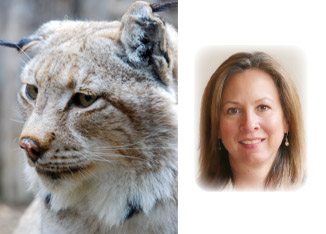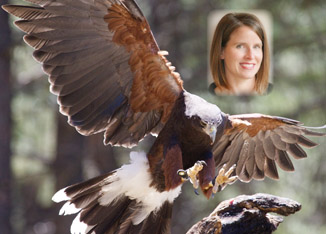New Leadership Team Brings a Vibrant Approach
A talented and innovative new leadership team has arrived at the High Desert Museum that includes Executive Director Dana Whitelaw, PhD, Director of Programs Christina Cid, PhD, Director of Development Heather Vihstadt and Director of Communications Sandy Cummings.
The passion and enthusiasm this group of women bring to the Museum is portrayed in this overview of this remarkable institution’s dedication to the High Desert environment.
The Museum was founded by Donald M. Kerr in 1982. Kerr had a passion for natural history that inspired a lifelong interest in environmental issues especially the protection of native animals. The Museum has stayed true to Kerr’s passion over the past 30 plus years, bringing regional wildlife, culture, art and natural resources together to promote an understanding of natural and cultural heritage of the High Desert.
“The museum uses indoor and outdoor exhibits, wildlife in natural-like habitats and living history demonstrations to help people discover and appreciate the high desert environment,” explains Whitelaw, who is always plotting ways to keep the galleries fresh, vibrant and compelling. “Through exhibits, wildlife and living history, the High Desert Museum creates learning experiences to help audiences discover their connection to the past, their role in the present and their responsibility to the future. We strive to make our members want to come back to visit.”
The Museum originally began as a natural history institute. “But over time,” offers Whitelaw, “the focus expanded to include how humans have influenced the landscape and how the landscape has shaped human culture and adaptation to the High Desert. This breadth of content provides our visitors with a very holistic perspective on both the environment and history and a more complete story of the High Desert.
Whitelaw emphasizes that the Museum has always been a place to learn and its core charge is to be an educational organization. “The Museum is a place for all ages and learners from early childhood to seniors,” she explains. “From the beginning, the Museum has strived to be a place of dialogue and conversation between parents and children, experts and laypeople – where learning comes from moments of discovery and inspiration. It is a classroom, in a sense, that immerses visitors in content and allows them to discover the components that are most compelling to them. Don Kerr wanted the Museum to be bounded by rivers, trees, mountains and the sage steppe, rather than walls. I think the Museum does an amazing job of being a place of learning and connection, and an incredible resource not only for our community, but for the tourist audience as well.”
Individual and corporate donations are very important to the sustainability of the Museum. “We feel very connected to the Central Oregon community. Individual and corporate donors are key to our survival and we remain grateful for all they do to support the Museum,” says Whitelaw. “We also have 200 local volunteers who keep the Museum running on a daily basis. We plan to continue giving back to the community through free events and special programs. For instance in September we hosted nearly 200 local educators for Teachers’ Night Out, a free, fun evening where we show our appreciation for teachers and organize a resource fair just for them.”
NEW INITIATIVES
Some new initiatives include the Open ‘til Dark events, festive evenings of live, local music where the community and Museum members are invited to explore galleries and exhibits.
“Several of our current and upcoming exhibits are not to be missed – we have a great exhibit called Water’s Extreme Journey in the largest gallery,” says Whitelaw. “It is a kid-friendly maze that explores the journey of a water drop and how the Deschutes watershed is part of that journey – complete with a zip line. Coming up this winter, we are curating a Brewing exhibit to explore the intricacies of the history, industry and community of beer brewing in the High Desert.”
The museum is accredited by the American Alliance of Museums. 59800 S Hwy 97, Bend, OR 97702, 541-382-4754, www.highdesertmuseum.org
MEET THE MUSEUM’s NEW LEADERSHIP TEAM
 Dana Whitelaw was named executive director of the Museum in February 2014. Previously she served as the Museum’s director of programs. Whitelaw holds a master of science degree and a Ph.D. in biological anthropology from the University of Colorado. Before moving to Bend she spent eight years teaching in the anthropology department at the University of Colorado and conducting research in Madagascar.
Dana Whitelaw was named executive director of the Museum in February 2014. Previously she served as the Museum’s director of programs. Whitelaw holds a master of science degree and a Ph.D. in biological anthropology from the University of Colorado. Before moving to Bend she spent eight years teaching in the anthropology department at the University of Colorado and conducting research in Madagascar.
What animal currently housed at The High Desert Museum do you most identify with?
We have several Harris’s Hawks at the Museum that are particularly intriguing to me since they are more social than most other raptors. I see a lot of similarities to other social species that I’ve worked with in the wild like baboons and lemurs.
What is your favorite outdoor sport and how does it reflect you leadership style?
I rowed in high school and college and that continues to be a favorite sport of mine. Crew is a very individual sport in many ways, but the boat is only as strong as each rower. To excel, each rower must strive to complete each stroke in unison with each other member. This requires incredible strength, communication and connection to each member of the team – I think it’s a great metaphor for how an organization can excel.
What previous professional experience most prepared you for your current roll at the High Desert Museum?
Having been at the Museum for six years prior to taking the executive director position, I know quite a bit about the nuts and bolts that make the Museum the great place that it is – primarily that it is made up of a rock star staff. Beyond my experience at the Museum, my professional life prior to that role involved teaching at the k-12 and college level as well as spending several years in the wildlife conservation research world, primarily in Africa but also in the High Desert. These experiences have helped shape my appreciation for inspiring learning and creating experiences that help our audience connect with the natural and cultural resources of the High Desert landscape.
 Christina Cid, director of programs, came to the Museum from the University of Texas at Austin, where she served as director of education at the Texas Natural Science Center for seven years. She earned a PhD in science education from the University of Texas at Austin in 2013, a master of education in science education in 2006 and BS in applied learning and development with a history emphasis in 1999. She also worked as a teacher in Austin from 1999 – 2003.
Christina Cid, director of programs, came to the Museum from the University of Texas at Austin, where she served as director of education at the Texas Natural Science Center for seven years. She earned a PhD in science education from the University of Texas at Austin in 2013, a master of education in science education in 2006 and BS in applied learning and development with a history emphasis in 1999. She also worked as a teacher in Austin from 1999 – 2003.
What animal currently housed at The High Desert Museum do you most identify with?
The porcupine because we are both herbivores.
What is your favorite outdoor sport and how does it reflect you leadership style?
Hiking with my two young sons. On our hikes, I make sure we stay on the right track, while giving my boys the freedom and flexibility to explore the area and pursue their interests. I know when to lead my children down a trail, and when to follow them. Sometimes hiking can be tough work, so I make sure I am a cheerleader and encourage my boys to reach our final destination.
What previous professional experience most prepared you for your current roll at the High Desert Museum?
My role as the director of education at the Texas Natural Science Center helped prepare me the most. In that position, I learned about all aspects of museum work, from caring for scientific collections to writing grants to developing exhibits, as well as how to manage multiple projects and departments.
 Sandy Cummings, the new director of communications for the Museum, worked for NBC News for 23 years, spending most of her career as a producer and senior producer for Dateline NBC. After leaving NBC in 2009, she formed her own video production company, TV Storyteller, with a focus on documentaries and helping nonprofits tell their stories. She earned a bachelor of arts in broadcast journalism from the University of Southern California.
Sandy Cummings, the new director of communications for the Museum, worked for NBC News for 23 years, spending most of her career as a producer and senior producer for Dateline NBC. After leaving NBC in 2009, she formed her own video production company, TV Storyteller, with a focus on documentaries and helping nonprofits tell their stories. She earned a bachelor of arts in broadcast journalism from the University of Southern California.
What animal currently housed at The High Desert Museum do you most identify with?
Snowshoe, our sweet old lynx. We’re both quiet type who sits back and takes it all in before we leap into action. Recently I had the opportunity to go into his enclosure to videotape him at mealtime and to pet him. It was heartwarming to see his bobtail wag. And we both enjoy a good nap.
What is your favorite outdoor sport and how does it reflect you leadership style?
Hiking. It takes planning and preparedness. In my work as on hikes: it’s important to know where you’re going and how to get there (and back). I find that spending time in nature provides quiet time to reflect and is where good ideas are born.
What previous professional experience most prepared you for your current roll at the High Desert Museum?
Working as a journalist (senior producer) for NBC News. It taught me to be flexible and to adapt well to situations as each day and every story was different. It also was great practice in meeting deadlines, gathering information, knowing what makes a good story and writing concisely.
 Heather Vihstadt, director of development for the museum, has been a nonprofit leader in Central Oregon for the last eight years. Prior to serving as the director of development for the High Desert Museum, she was the executive director for the Education Foundation for Bend-La Pine Schools and the council director for Girls on the Run of Deschutes County. Vihstadt also holds a masters in nonprofit management degree from Regis University with a certificate in capacity building.
Heather Vihstadt, director of development for the museum, has been a nonprofit leader in Central Oregon for the last eight years. Prior to serving as the director of development for the High Desert Museum, she was the executive director for the Education Foundation for Bend-La Pine Schools and the council director for Girls on the Run of Deschutes County. Vihstadt also holds a masters in nonprofit management degree from Regis University with a certificate in capacity building.
What animal currently housed at The High Desert Museum do you most identify with?
Of all of the animals currently housed at the High Desert Museum, I most identify with the Harris’ Hawks. Known as Wolves of the Sky, they live and work in social groups. In addition, they are adaptable and utilize different strategies in hunting, which greatly enhances their likelihood of survival. I relate to their behavior because I whole-heartedly believe in teamwork and I know that flexibility and ingenuity are also essential to success.
What is your favorite outdoor sport and how does it reflect you leadership style?
Like most Central Oregonians, I love the outdoors, but my favorite sport is trail running. I enjoy the rhythm of my breath and my footsteps. I love listening to the sounds of a nearby creek, leaves blowing in the wind, and birds calling. I enjoy watching the sunrise and seeing a myriad of colors in the skies above. Being in nature centers me. It is a space where I can clear my mind, problem solve and generate new ideas. It is also much like life. There are hills and valleys, obstacles to overcome and moments of exhilaration and challenge. I also enjoy spending this time with friends as we encourage one another to move forward.
As far as how running parallels my leadership style, I strive to listen and observe before decision making. I also appreciate collaboration and utilizing our respective strengths to accomplish shared goals.
What previous professional experience most prepared you for your current roll at the High Desert Museum?
The professional experience that best prepared me for my role at the High Desert Museum was serving as the executive director for the Education Foundation for Bend-La Pine Schools. I worked with a very dedicated board of directors who provided invaluable guidance and insight. In addition, the position permitted me to wear many hats and allowed me to learn much about fundraising, strategic planning, finance and governance.





